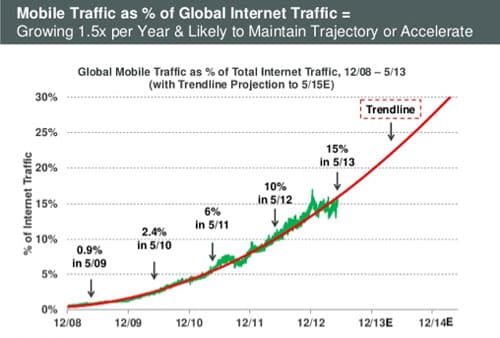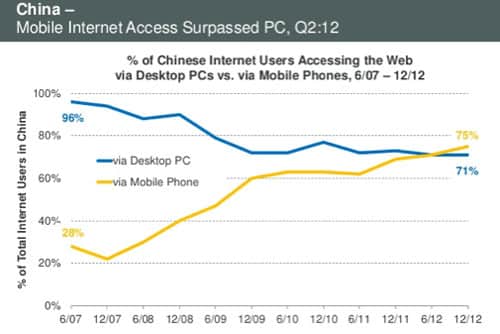Have we reached an inflection point for mobile marketing in student recruitment?
Mobile marketing is hardly a new idea. Indeed, considerable ink has been spilled in the general press and otherwise as to the rising share of Internet traffic claimed by mobile and the expanding range of mobile marketing ideas and strategies either in use today or on the drawing board for tomorrow. We come back to the topic in today’s post though because it feels to us like we are approaching - perhaps we have reached it already - an inflection point for mobile marketing in international student recruitment. Because of this, ICEF Monitor readers can expect more on mobile marketing in our digital pages in the months ahead. For the moment though, let's consider a few recent findings on the rising tide of mobile Internet usage and how this is beginning to impact marketing spending and marketing strategy.
Mobile’s share of global web traffic
As of May 2013, mobile traffic accounted for 15% of global Internet traffic - up from 10% of global traffic a year earlier and 6% in May 2011.

Mobile usage in Europe and China
In looking at mobile usage in Europe, the UK, Ireland and Russia lead the pack, as this graph illustrates:


Mobile’s growing share of online ad spending
Mobile advertising revenue is growing at a pace beyond earlier estimates and is expected to reach US $11.4 billion worldwide in 2013 (as compared to US $9.6 billion in 2012). And a recent report from US research firm Gartner projects that global mobile advertising revenue will grow by 400% between 2011 and 2016, reaching US $24.6 billion. “Marketers need to acknowledge that mobile advertising is now becoming mainstream; at the same they need to think holistically about how mobile interactions can support their marketing and customer relationship aspirations and avoid treating mobile advertising as a channel silo,” said Andrew Frank, a Gartner analyst. Looking just at ad spend patterns in the US, Mobile Marketer reported in June:
“Mobile's share of digital ad spending is growing more quickly than expected and, as a result, the spend on desktop ads will peak next year as marketers turn their focus to reaching smartphone and tablet users, according to new data from eMarketer. In 2013, the bulk of incremental growth in overall digital advertising will come from mobile, which will account for US $7.7 billion of the US $41.9 billion spent on digital ads this year. The trend will accelerate going forward, with desktop banner and search advertising expected to see flat or declining growth in 2014 for the first time ever.”
“Consumers today spend more time with mobile devices than ever before,” said Clark Fredricksen, vice president of communications at eMarketer. “They’re also more likely than ever to research and buy products using phones and tablets. As a result, mobile advertising is on track to account for over 40% of digital ad spending in three to four years. It’s incredible growth.”
Mobile and student recruitment
In September 2012, ICEF Monitor reported the finding that 52% of US college prospects viewed educator websites on mobile devices. But more recent data suggests that the use of mobile devices among prospective students, and the degree to which mobile factors in student recruitment, has only expanded in the year since. A new study - 2013 E-Expectations: The Impact of Mobile Browsing on the College Search Process - produced by Noel-Levitz, OmniUpdate, CollegeWeekLive, and the National Research Center for College & University Admissions reports the following:
- 78% of study respondents have regular access to a mobile device; 80% of which are smartphones, tablets, or an iPod Touch.
- Perhaps reflecting the high-involvement nature of the choice of an education institution/destination, 82% of respondents said they preferred to look at educator websites on a desktop device rather than a mobile device. However, 68% said they have viewed educator websites on a mobile device (up from the 52% reported in 2012).
The study is based on a survey of over 2,000 college-bound US high school juniors and seniors, and covers a wide range of their online and mobile browsing behaviour. In order to determine the impact that mobile browsing is having on the college search process, it explores their usage of email, phones, and social media, as well as the influence of websites on their perception of a campus and a college website's content priorities (as illustrated below).




















